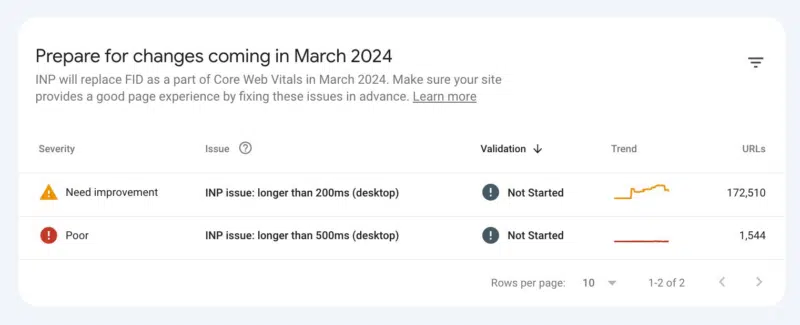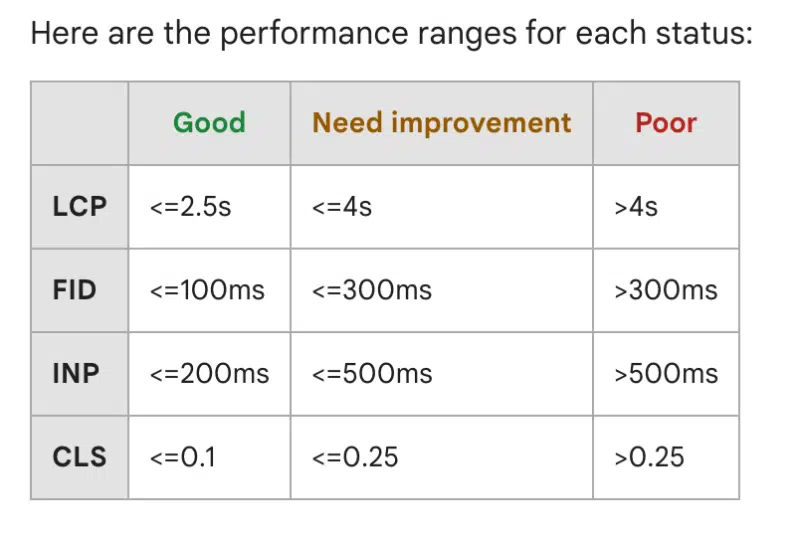Google adds INP report to Search Console
In order for you to prepare for when Google replaces FID with INP as a core web vital metric, Google has launched a new report to aid you.
Google has launched a new report within Google Search Console to see how well you perform with the INP, Interaction to Next Paint, Core Web Vital metric. As a reminder, Interaction to Next Paint (INP) will replace First Input Delay (FID) as a metric for Core Web Vitals in March 2024.
Google launched this new report today to allow site owners to prepare for the upcoming change.
What the report looks like. Here is a screenshot of the report:

INP (Interaction to Next Paint) is a new metric that will replace FID (First Input Delay) as a Core Web Vital in March 2024. “Until then, INP is not a part of Core Web Vitals. Search Console reports INP data to help you prepare,” Google explained.
How to access the report. The report is within Search Console can be accessed by clicking this link and selecting a property.
More details. Google wrote in its help documentation:
- INP (interaction to next paint): A metric that assesses a page’s overall responsiveness to user interactions by observing the time that it takes for the page to respond to all click, tap, and keyboard interactions that occur throughout the lifespan of a user’s visit to a page. The final INP value is the longest interaction observed, ignoring outliers.
- Group INP shown in the report means that 75% of visits to a URL in this group had this value or better.
Here are the performance ranges for each status; notice the INP range says to be marked as “good” you need to be less than 200ms.

What is Interaction to Next Paint? INP is a metric that uses data from the Event Timing API. It assesses the responsiveness of a webpage.
An interaction that causes a page to become unresponsive results in a poor user experience, Google said. INP observes the latency of all interactions a user has made with the page and reports a single value which all (or nearly all) interactions were below.
Google provided the following example of what poor versus good responsiveness looks like:

On the left, long tasks block the accordion from opening. This causes the user to click multiple times, thinking the experience is broken. When the main thread catches up, it processes the delayed inputs, resulting in the accordion opening and closing unexpectedly.
Rankings impact. Google reiterated that Core Web Vitals do not guarantee good rankings in Google Search, wrote Martin Splitt, Developer Relations Engineer at Google.
- “Great page experience involves more than Core Web Vitals. Good stats within the Core Web Vitals report in Search Console or third-party Core Web Vitals reports don’t guarantee good rankings,” according to Splitt.
A good page experience is part of Google’s overall core ranking system. Core Web Vitals – while maybe not a direct ranking signal – is one way you can try to understand whether you’re achieving a good page experience.
However, Google uses other signals as part of its core ranking system to determine what makes a good page experience, outside of Core Web Vitals.
“There are many aspects to page experience, including some listed on this page,” Danny Sullivan, Google’s Search Liaison, told Search Engine Land. “While not all aspects may be directly used to inform ranking, they do generally align with success in search ranking and are worth attention.”
Why we care. So now you can see how Google will judge your pages based on this new INP core web vital metric. You have several months to prepare before this goes live in March 2024. Until then, I would not panic about this metric, it will probably be a very minor, if any, ranking signal. But it is another performance metric you can use to try to make your site better for users, so show it to your developers and see if they can improve it, that is, if it is not good now.
This is what a good result looks like to Google:

Related stories